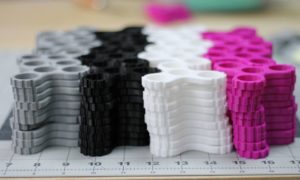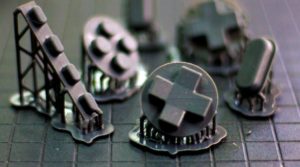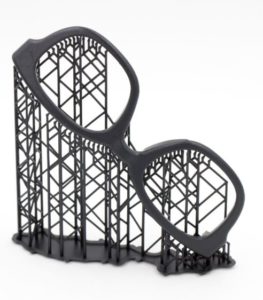 It isn’t easy running a business. It’s even more of a challenge to run two businesses, but that’s what Christina Perla does. Perla is the Co-Founder and Managing Partner of Makelab, a 3D printing service bureau based in Brooklyn, New York. She’s also the Co-Founder and Creative Director of Tangent Design, a product design and development firm also located in Brooklyn. Perla has a degree in industrial design, and her work has led her to become an expert in 3D printing. Through Makelab in particular, she helps bring the technology to clients every day, offering professional 3D prints for a variety of applications using both FDM and SLA technology. Her work allows her to have an up-close view of the 3D printing industry and its trends, and she was willing to share her thoughts on the industry – as well as what it takes to run two businesses at once – for the latest installment in our Spotlight on Women series.
It isn’t easy running a business. It’s even more of a challenge to run two businesses, but that’s what Christina Perla does. Perla is the Co-Founder and Managing Partner of Makelab, a 3D printing service bureau based in Brooklyn, New York. She’s also the Co-Founder and Creative Director of Tangent Design, a product design and development firm also located in Brooklyn. Perla has a degree in industrial design, and her work has led her to become an expert in 3D printing. Through Makelab in particular, she helps bring the technology to clients every day, offering professional 3D prints for a variety of applications using both FDM and SLA technology. Her work allows her to have an up-close view of the 3D printing industry and its trends, and she was willing to share her thoughts on the industry – as well as what it takes to run two businesses at once – for the latest installment in our Spotlight on Women series.
Please tell us about your background, history and current work.
“I attended Pratt Institute for Industrial Design. While in undergrad, I accepted an internship at Converse for Accessories Design which turned into a job upon graduating from Pratt. I then made the jump to the startup world by working at a small wearable technology startup. While I was working at the startup, I began to freelance and eventually left my full-time job to freelance full time.
Meanwhile, my partner Manny, also an industrial designer, was doing custom prototyping and model making. We had this crazy idea that maybe we could start a business together, and after a few months of talking about it, we did. We started Tangent Design. Our focus with Tangent is taking on industrial design projects and provide a full spectrum of services. During the process, we utilized 3D printing pretty heavily through a company called 3DUniPrint. We 3D printed with them so much we became close with the owner, Rico. About a year later, Rico’s situation changed resulting in him and his family moving to China. To salvage 3DUniPrint’s operations, Rico asked Manny and I to take over his company and that’s when Tangent Design acquired 3DUniPrint. A few months later, we changed the name to Makelab. So in a timespan of 2.5 years, we started a company and acquired another. It’s been a whirlwind of a time, but a good one to say the least.”
When and how did you first become interested and involved in 3D printing?
“I’ve known about 3D printing for a pretty long time now. It was available during my time at Pratt Institute, but I never really utilized it. I didn’t fully understand it and was actually quite terrified of it so I was hesitant to touch a machine. 3D printing seemed so intimidating at the time – it’s funny looking back now. It wasn’t until my partner, Manny, purchased a first generation PrintrBot that I started to open up to the idea of it. Around the time we started Tangent, we realized we would be needing rapid prototyping and bought an XYZ Da Vinci. A few months later, we upgraded to a MakerGear (after the Da Vinci stopped working). After messing around with 3D printing, I realized it wasn’t as terrifying as I thought and actually pretty simple to pick up.”
What inspired you to begin Makelab?
“With Tangent Design firm in place, it was an organic business move that made sense for us to improve workflow efficiency and also cut costs by bringing 3D printing in-house. While still 2 separate companies, it is tremendously easier to prototype having all the software resources and a well-rounded team to execute our designs.”
What are some of the challenges of owning two businesses?
“The startup world is infamous for it’s ‘hustle and grind’. Multiply that by two and it can be nuts. I’ve definitely had to step up my time management and organize my life a bit more. I use a variety of tools to keep up with my own life and maintain these businesses. Staying on top of tight operations for one company is difficult enough before adding in the complexities of switching gears from one company to another. Both Tangent and Makelab have extremely different systems, processes, sequences, and challenges. It’s something I’m still conquering now. I spend an hour or two a day just recording the day’s happenings so I don’t have to try to keep everything in my head. Then begin every morning with a review. I’ve embraced Evernote which has become my personal assistant.”
What has been your experience of diversity in the 3D printing industry?
“I have definitely seen tremendous diversity in the tech and design industry. However, I’ve seen very few women heading the tech industry, although that seems to be changing every day. At Makelab we engage with many different partners and customers and I would definitely say that 75% is men. It’s quite interesting. I feel 100% comfortable being a minority in tech & design, but I [not often] have these moments where I realize all of my emails, calls, messages have been to men and that realization can feel a bit odd and off-balanced at times. But I try not to let this observation deter me because that will just halt momentum rather than enhance productivity.”
In your work, what are some of the biggest misconceptions you’ve seen about 3D printing?
“Oh man, the misconceptions are endless. 3D Printing is seen as a technology that is super simple, easy, quick, and fast. But it really depends on what you’re comparing it to. For example, compared to manual woodworking or other production methods, 3D printing is incredibly fast, accurate, and easy. But sometimes people are surprised that a print can take up to 34 hours. There is also a slight misconception about what materials are available with 3D printing. Yes there is the classic ABS & PLA, the hot glue gun style of printing that is what is most recognized. But at Makelab we’ve actually started to offer more engineering materials that are stronger and higher quality. It’s called our Pro+ line, currently in beta.”
What trends do you see happening in 3D printing in the near future?
“There are a couple that are top of mind!
First, Desktop SLS. We are really interested in the development of making nylon SLS printing more friendly. Currently, it’s required that these machines be in specific facilities due to the fine powder, but a company called Formlabs just made a huge advancement to bringing that technology to a more office/desktop-friendly environment. Printing using SLS technology not only is quick, but it also eliminates the need to remove ‘supports’. This is incredibly useful and a lot quicker than either dissolvable supports or manually removing supports.
Second, higher quality desktop machines. We are so excited to see high quality machines come to desktop format. Right now, the industrial machines are pretty high quality, but not everyone has access to those. Desktop machines are more accessible by small businesses, designers, hobbyists, and engineers. Zortrax definitely set the bar high for this, but we are excited to see other companies jump on the bandwagon for this as well.”
What are some of your plans for the future of your businesses and career?
“Our goal is to enable Makelab to be more of an education source for 3D printing – a knowledge center of sorts. We want people to know about 3D printing and it’s true capabilities as well as best print practices. We want to make 3D Printing more accessible while also making it easier for people to print by educating them on the ‘hacks’ of 3D printing. We find ourselves talking to many customers about the different materials that are printable, and we are working on a more comprehensive material guideline on our website for our Pro+ line. We figure the more people know about 3D printing, the more simple each process is.”
What industries haven’t been utilizing 3D printing, but could benefit from it?
“We see 3D printing being more useful in construction, furniture, lighting, and DIY home improvement.
Currently there’s a trend of ‘hacking’ and ‘DIY’- whether it be hacking your MacBook Pro, fixing your iPhone, amping up your PC. It’s huge, there are even sites that facilitate this. We hope to see more libraries of parts that work with product standards being formed.
We also see 3D printing being more integrated with tools and hardware. Instead of stores selling pre-made products/hardware, you’d be able to search their library, lease the file for a one or two time use, and then print your part.
We’d also love to see furniture use the technology more. Much of furniture is actually put together using a mixture of plastic parts and metal hardware. We’d love to see students be able to more quickly prototype furniture pieces using 3D printing, rather than having to make a mold, cast the plastic and then paint/color it. 3D printing takes care of that in one step.”
Perla’s strong work ethic and obvious passion for 3D printing and design have helped her to become successful, and she’s willing to share that success and knowledge through her plans for implementing educational outreach. We look forward to following her work with Makelab in the future.
If you are interested in sharing your story, or know a woman we should get in touch with for this new series, please reach out any time. Send us an email or connect on Twitter. We’re looking forward to sharing more stories about women in 3D printing. Find all the features in this series here.
We are also featuring educators focusing on training and teaching 3D printing skills; see all these features here.
Discuss this and other 3D Printing topics at 3DPrintBoard.com, or share your thoughts below.
Subscribe to Our Email Newsletter
Stay up-to-date on all the latest news from the 3D printing industry and receive information and offers from third party vendors.
You May Also Like
Profiling a Construction 3D Printing Pioneer: US Army Corps of Engineers’ Megan Kreiger
The world of construction 3D printing is still so new that the true experts can probably be counted on two hands. Among them is Megan Kreiger, Portfolio Manager of Additive...
US Army Corps of Engineers Taps Lincoln Electric & Eaton for Largest 3D Printed US Civil Works Part
The Soo Locks sit on the US-Canadian border, enabling maritime travel between Lake Superior and Lake Huron, from which ships can reach the rest of the Great Lakes. Crafts carrying...
Construction 3D Printing CEO Reflects on Being Female in Construction
Natalie Wadley, CEO of ChangeMaker3D, could hear the words of her daughter sitting next to her resounding in her head. “Mum, MUM, you’ve won!” Wadley had just won the prestigious...
1Print to Commercialize 3D Printed Coastal Resilience Solutions
1Print, a company that specializes in deploying additive construction (AC) for infrastructure projects, has entered an agreement with the University of Miami (UM) to accelerate commercialization of the SEAHIVE shoreline...




































